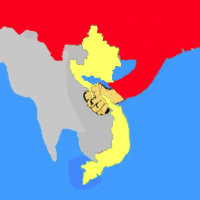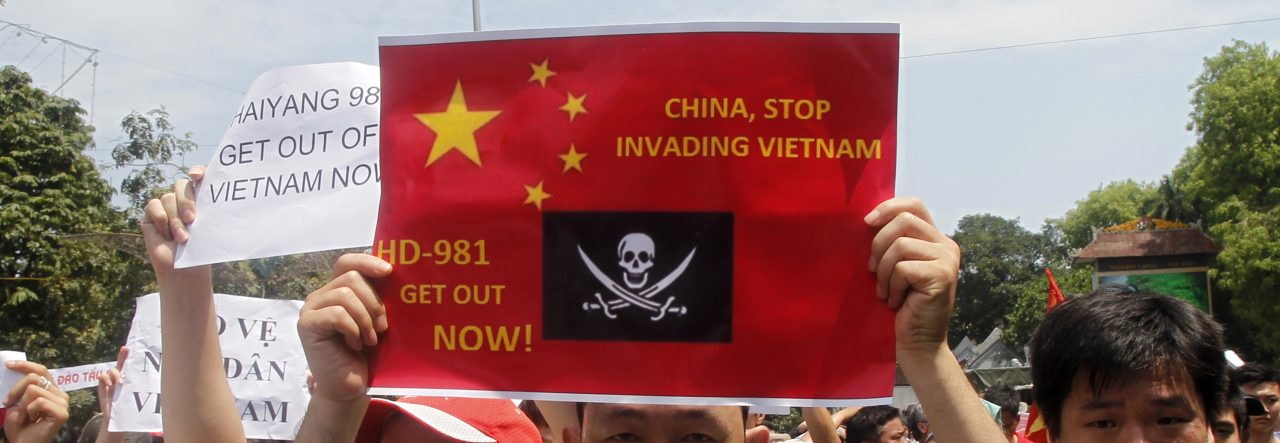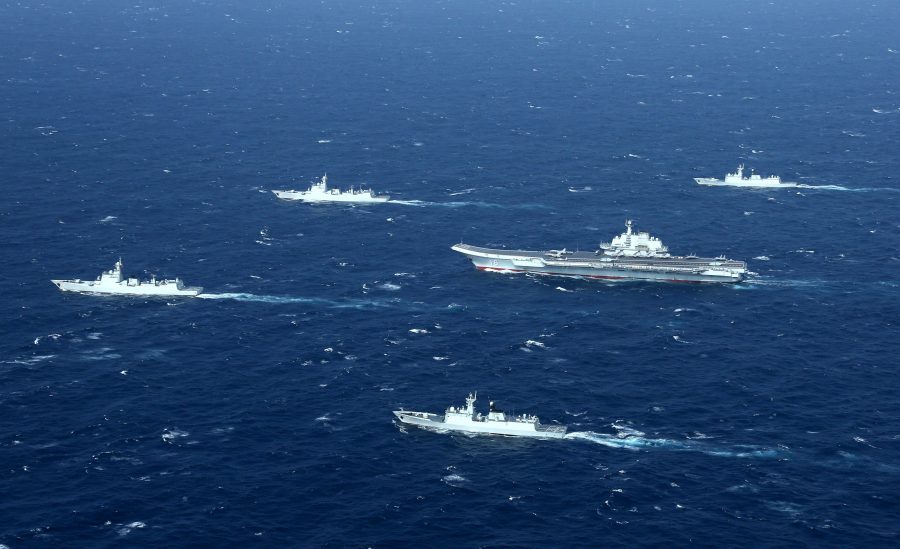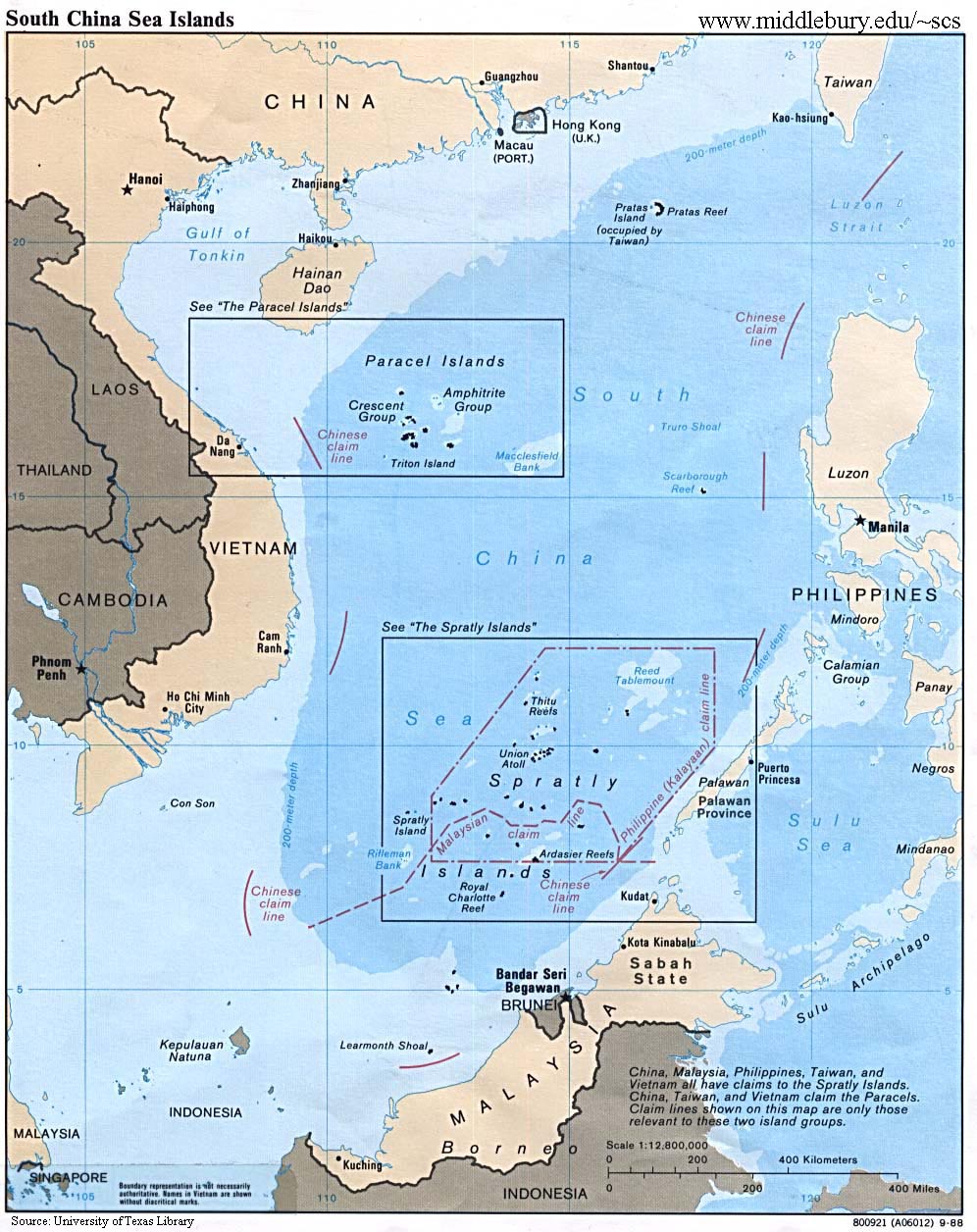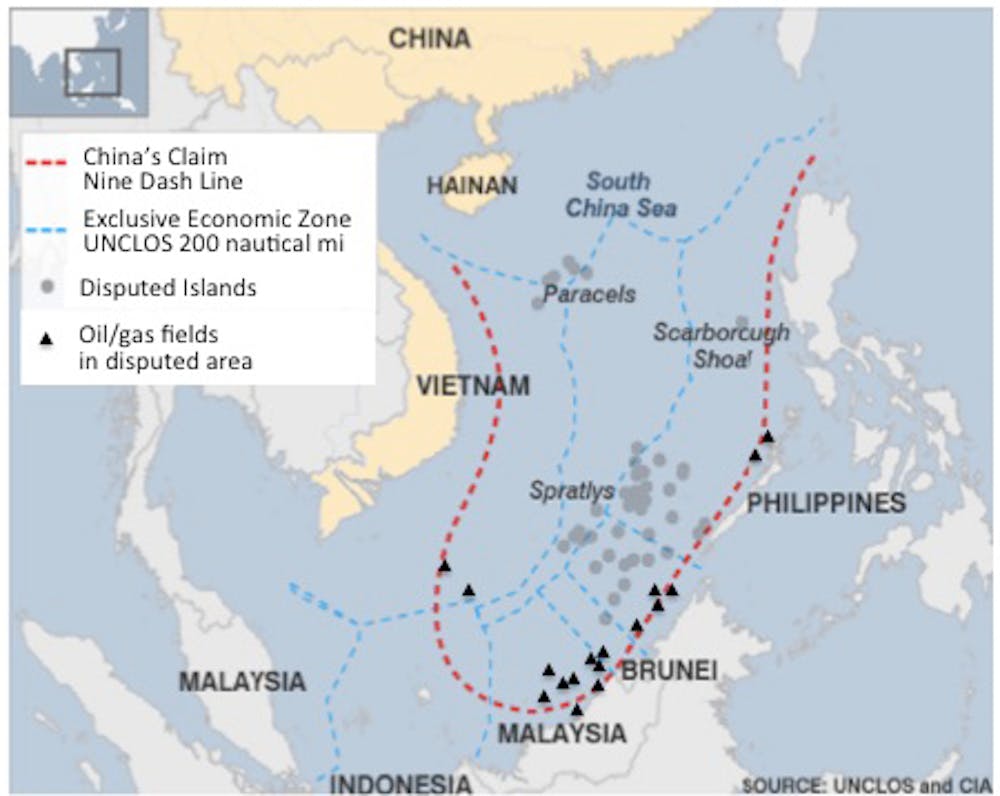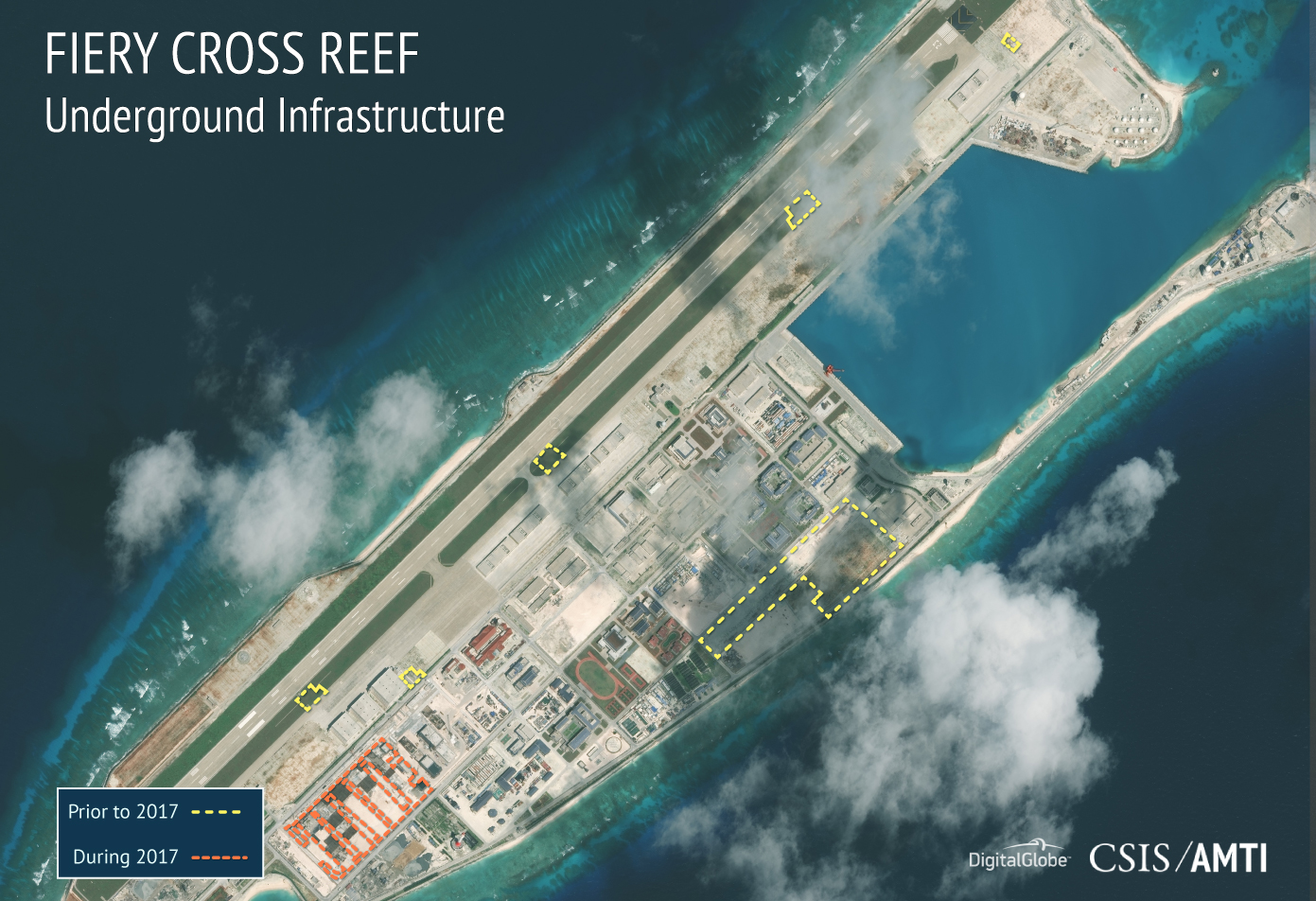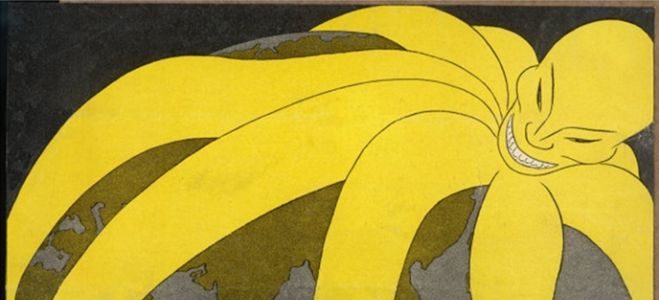Progress of the stranglehold of China on the Paracel and Spratly at the expense of Vietnam
By Dang Phuong Nghi
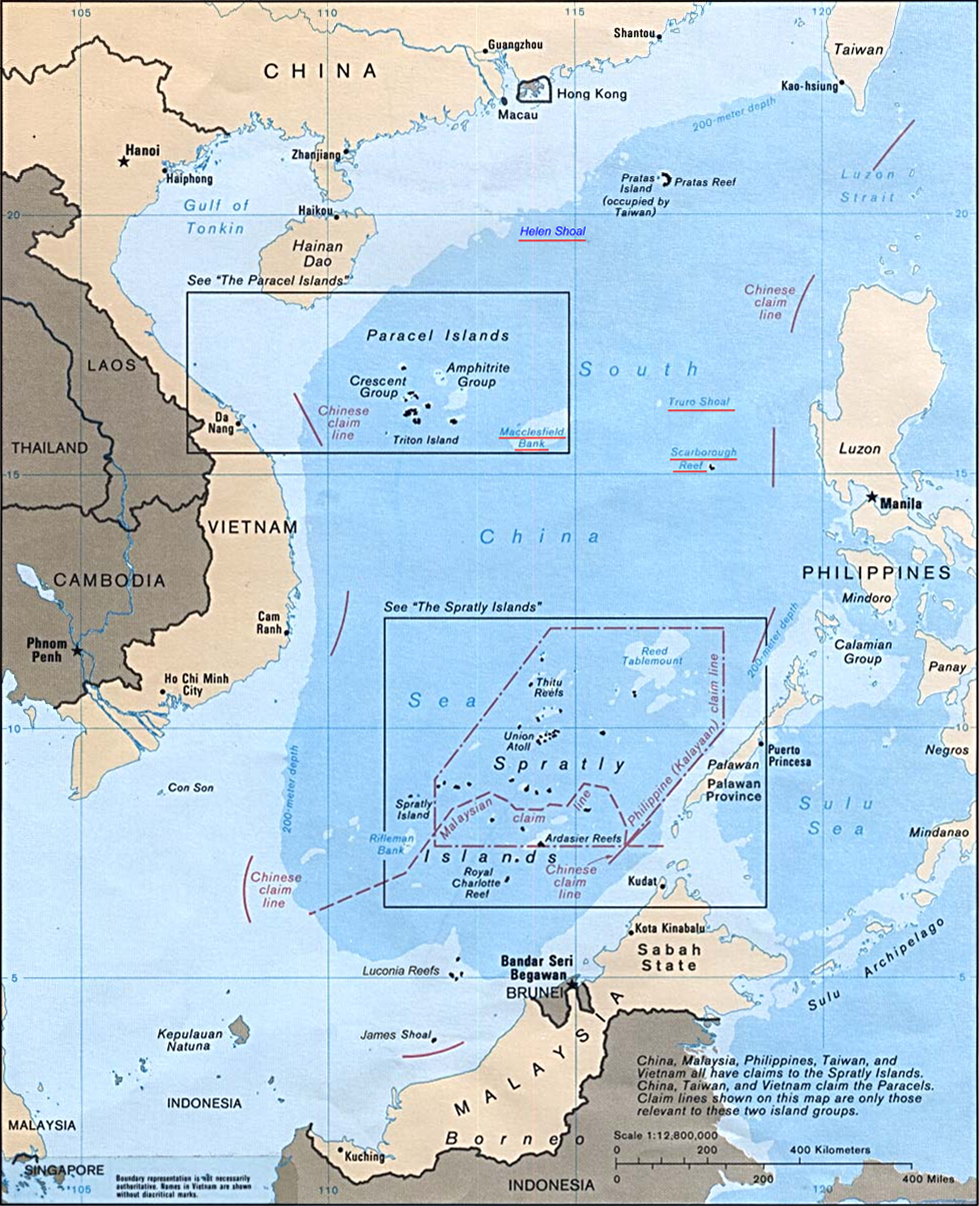
Firstly, let us agree on the right name for the Sea that all western media call China Sea while no coastal country in the region calls it by this name. In these times where China wants to take control of all the Sea at the expense of other riparian countries, especially the south part of it beyond the 18th parallel which does not bath any of Chinese coast, to call Chinese, even by acquired use, a sea which shelters the territorial waters of other countries and is the subject of conflicting claims, is to comfort the China’s delirium of predatory power and to espouse its claims.
As the concerned sea borders the East Asia countries, we propose to call it simply East Asia Sea (EAS), leave to clarify North of East Asia Sea (NEAS) and South of East Asia Sea (SEAS) if we want to refer to its North and South parts.
Until the beginning of the 20th century, before the prospect of large hydrocarbon deposits beneath its waters arouses the greed of East Asia Sea riparian countries, the ten or so nations that share it did not make it a subject of contention, and Vietnam’s authority on the two archipelagos, Paracel (15.000 km2) and Spratly (160.000 km2), administered by the Nguyễn rulers since the 17th century, was not disputed by any country, including China, whose border governors made it a duty to escort to Vietnam the boats stranded on their beaches as the result of storms in the vicinity of the Paracel and Spratly, on the pretext that everything related to these archipelagos belonged to Huế court. It must be said that these archipelagos composed of islets, atolls and reefs, mostly submerged, whipped by the wind, were of interest to anyone, except fishermen and guano collectors.
Things changed starting in 1921 with the “dreams of a great China” of the leaders of the new Republic of China (concerning the archipelagos, the claims of non-communist China and communist China are similar), determined to establish Chinese presence in the South of the East Asia Sea, the crossing point for all ships trading between Europe and Asia : based on the report of a reconnaissance trip beyond Hainan island by a small fleet of Qing’s admiral Lý Chuẩn (name phonetized in Vietnamese) in 1909 which refers to the discovery of islands in the southwest of Hainan, the government of South China declared them Chinese under the name of Xisha (name then appeared for the first time), despite the fact that these islands which had already the name of Hoàng Sa in Vietnamese and Paracel in French, were already under the jurisdiction of Vietnam, or rather under that of the General government of Indochina, Vietnam having become French colony ; some Vietnamese fishing families lived there but a pre-reconnaissance patrol under Ngô Kính Vinh’s (name phonetized in Vietnamese) command took them prisoners and brought them to Hainan so that the admiral could say them deserted. The Chinese attached the islands to the district of Châu Nhai (name phonetized in Vietnamese) in Hainan, whereas they depended since the 17th century of the provinces of Quảng Nam, then of Thừa Thiên, again of Quảng Nam (the Spratly were incorporated for a long time into the Paracel before being administered separately by the province of Bà Rịa in 1933, then of Phước Tuy in 1956). The manoeuvre of the government of Canton, not recognized by the international community, was not taken seriously by colonial France. But in 1935 the Republic of China officially claimed the property of all the islands of the South East Asia Sea, and to reinforce its claims ordered the surreptitiously erecting of backdated stelae on four of Paracel islands!
During the second world war, in 1939, Japan took over the Paracel it occupied until 1946. That year, taking advantage of the disarmament of the Japanese entrusted to it by the Allies according to the Postdam agreements, the Republic of China seized the largest island in the Paracel (Phú Lâm, Woody island, 2.6 km2), then in 1947 the largest island in the Spratly (Ba Bình, Itu-Aba, 46 ha), the only one in this archipelago to have potable water, but following its expulsion from the mainland to Formosa, it had to withdraw from these islands in 1950. At the time of the San Francisco conference in 1951 by which treaty Japan returned the two archipelagos to the Vietnamese government, and where Chinese claims on them were unanimously minus three rejected, Trần Văn Hữu, king Bảo Đại’s Prime minister, was able to declare Vietnam sovereignty on the Paracel and the Spratly without any protestation from the 50 other conference attendees from which, it must be said, the two China were excluded.
In 1948, before packing for Formosa, Tchang Kai Chek (Jiang JieShi) had a map of China printed with a fancy U shape line called buffalo tongue as its maritime boundary, obtained by joining 11 traits supposed to delimit the territorial waters of China and thus attributing to China 70% of the area of the South East Asia Sea at the expense of the other coastal countries. This map went unnoticed, but in 1953, Beijing made it reprinted with modification to the number of traits, reduced to 9 but located so that the portion of sea the Chinese attributed to themselves now comprised 80% of the total area (3.5 million km2). For internal use, the U line was hardly invoked before 1998 in the various declarations of China on its maritime zones ; however this map is a time bomb because, introduced in teaching, it had since inculcated in the minds of all the Chinese the conviction that the archipelagos and the sea around belong rightfully to China, exacerbating an easily manipulated nationalism.
In 1956, making use of the evacuation of French troops and the quandaries of the new government of South Vietnam to which was devolved the sovereignty over the two archipelagos according to the Geneva Treaty (1954), the two China took over Itu-Aba the largest Spratly island and some coral banks nearby for Taipei, and the Eastern part of the Paracel (which includes Woody island) for Beijing, that they hold since. The government of South Vietnam could only protest and strengthen the guard on the remaining islands. In 1959, Beijing sent 82 soldiers disguised as fishers to attack the Western Paracel, but they were unmasked and made prisoners by South Vietnamese soldiers before being sent back to China.
The withdrawing of US troops after the Paris treaty (1973) and the entanglements of the South Vietnam army (ARVN) now alone against Hanoï and its Sino-Russian allies were an opportunity for Beijing to send on the 1/14/1974 two warships to the Paracel to take over its western islands still under Vietnamese administration ; the four South Vietnamese destroyers sent to the rescue could not get through in the ensuing naval battle (1/17-20/1974) although they were more numerous, because the technical staff of the destroyers recently handed over to the ARVN by the US army had not yet received any serious training and because the Americans had removed sophisticated equipment from these ships. The Vietnamese had to retreat after losing 75 sailors against 21 on Chinese side, leaving the Chinese now masters of the whole Paracel archipelago. The most outrageous is that the US 7th fleet that sailed off the East Asia Sea refused to lend a hand to the South Vietnamese Navy, on the order of Washington itself, supposedly allied to Saïgon, and this despite Nixon’s promise to intervene in case South Vietnam was attacked. Even worse, Washington put pressure on president Nguyễn Văn Thiệu so that he did not let the 5 already paired planes take off to go repel the Chinese from the islands. The fact is that the United States had just renewed relations with China and had somehow “sold” the Paracel to their new partner.
In the 1970s, the weakness of South Vietnam struggling with a murderous war aroused the desire of the other coastal countries to seize at least part of the Spratly, the richness of which in hydrocarbons and fish were now well known. In 1977, president Ferdinand Marcos of the Philippines, under the pretext that one of his citizens, Tomas Cloma, had taken possession in 1947 of some Spratly islets deserted by the Japanese to install a Freedom land (Kelayaan) before being expelled in 1956 by the Taïwanese who came to reoccupy Itu-Aba, claimed the sovereignty of his country over the islets and reefs thought to be part of the Kelayaan and over those near its territorial waters. Actually, as early as 1968 the Filipinos had already laid hold of some islets and reefs without garrison. As they were South Vietnam’s ally in the war, the Saïgon government let it go without protest, but managed at the end of the war to take back one islet. And since, the Philippines control 3 reefs and 7 islets (out of 14 in total) including the 2nd largest of the archipelago (Thitu island, Thị Tứ), leaving to Vietnam 21 reefs and 6 islets including Spratly island which gives its name to the archipelago.
In 1979, it was Malaysia’s turn to proclaim its sovereignty over all the reefs it believed to be on its continental shelf, and from 1983 garrisoned there to overrun and defend them. Among the 5 reefs and banks it holds, two are also claimed by the Philippines and one by Brunei. However, Brunei has no Navy and has so far been content to assert its right without indulging in military violence.
The appetite of the other riparians revived that of China which took part on a much larger scale. At the end of the Sino-Vietnamese war, seizing the defeatist reversal of Hanoï leaders, China decided to take over the Spratly. In 1987-1988, after laying hold of several Vietnamese reefs (Fiery Cross reef, London reef, Gaven reef, Hugh reef) left without guard, three Chinese frigates were sailing towards Johnson South reef (Gạc Ma) when, as they were about to disembark, they saw arrive a hundred of Vietnamese on three transport boats that came to build a terminal and plant a flag ; according to the official version, a battle arose (3/14/1988) as the result of which 64 Vietnamese were killed and 9 taken prisoner against 6 dead and 18 wounded on the Chinese side ; unable to withstand the fires of the enemy, the Vietnamese had to run away and let the Chinese take over the reefs. The reality unveiled by General Lê Mã Lương, general director of Vietnam’s military history museum, was more tragic and revolting : (cf. https://www.rfa.org/vietnamese/in_depth/who-ord-no-fir-in-garma-03122015052720 ) The Defence minister Lê Đức Anh, acquired with other leaders at the idea of a general capitulation to China, had prevented the arming of boats and banned the distribution of guns to sailors, and had therefore deliberately sent the hundred or so soldiers to death under Chinese cannons, history to make believe in the opinion that the transfer of the reefs to China was not decided in advance but due to a military defeat. Note in this South Johnson reef case the collusion between Taïwan and the People’s republic of China : the Chinese frigates were supplied by Taïwanese soldiers from Itu-Aba (as they will be later in 1995 at the moment of the attack of Filipino Mischief reef) ; besides, their solidarity in the conquest of the archipelagos is confirmed in a statement from the then Taïwan defence minister Cheng Wei-Yuan : “If war breaks out, the national army (of Taïwan) will attend the Popular army in its fight” (cf. https://vi.wikipedia.org/wiki/H%E1%BA%A3i_chi%E1%BA%BFn_G%E1%BA%A1c_Ma-C%C3%B4_Lin-Len_%C4%90ao_(14-3-1988 ).
From the Chengdu treaty in 1990, China feels stimulated to accelerate its stranglehold on the East Asia Sea, sure now of the tacit submission of Vietnam, its main opponent : Far from protesting violently against China’s growing encroachments in its possessions, even in its exclusive economic zone (EEZ) then in its territorial waters as defined by the United Nations Convention on the Law of the sea (UNCLOS) – according to this Convention a coastal State is sovereign on the soil, the subsoil and the airspace of its territorial waters up to 12 miles or to about 20 km, and beyond up to 200 miles or about 370 km, it is entitled to fishing, building and exploitation of the soil and the subsoil, but cannot oppose the free movement on the waters and above -, in the name of the preservation of peace with the mighty “friend” of the north, Hanoï jails any citizen daring to manifest loudly its hostility to China. Beijing first began by having its parliament ratify in 1992 the historical sovereignty of China over the South East Asia Sea then ordered its historians to search the Chinese archives for supporting evidence. Taipei followed it in 1995 to raise the same claim over the whole sea included in the U line, but unlike China, suspended it in 2015 except for Taiping island (Itu-Aba) and the Pratas already in its hands.
Afterwards, with bogus historical proofs that speak mostly of island discoveries during exploration trips, Beijing presented them to UNO in 2009 with the map of its territorial waters delimited by a 9 traits line or in buffalo tongue shape, to claim sovereign rights over 80% of the Eat Asia Sea, line on which it added in 2014 a 10th feature to encompass this time 90% of the sea. But its evidence has no convincing force, especially since UNCLOS considers historical rights only in the case of continuity of peaceful occupation. Besides, in all the maps of China from the oldest to 1933, Chinese territory stops at Hainan island, its extreme point in the south, and the South East Asia Sea as well as the archipelagos within were foreign to it. And in June 2012, regardless of international opinion, Beijing gave the archipelagos and the surrounding U-sea the administrative status of a town named Sansha (ie. the three archipelagos : the Paracel, the Spratly and the Macclesfield bank / Xisha, Nansha and Zhongsha) whose municipal seat is Woody island. This provocation in addition to the attacks on Vietnamese fishermen triggered among the Vietnamese people regular demonstrations, for once allowed as remotely guided by the faction of power hostile to subjection to China. Actually, this creation of Sansha was already decided in November 2007 but was not officially declared and had raised many protests and demonstrations of Vietnamese from abroad as much as in the country.
Notwithstanding unanimous protests against its pretensions, China consolidates the conquered areas and deploys its new military power there, putting everyday a little more before the fait accompli the world, paralyzed as much by its threats as by its financial blackmails. As soon as 1990, it began to build an aircraft runway on Woody island (Paracel) and one thing leading to another constructed there a real military base with port, airport and missile hangar. In 2013, it was the Spratly’s turn to be polderized and militarized on a much larger scale ; on the 9 reefs it occupies, China erected artificial islands which form a set of 13,5 km2 with ports, airports, etc. (while the total area of the 14 natural islets of the entire archipelago is only 2 km2), at the cost of immense ecological destruction : nearly 5 million m3 of sand and corals pumped, displaced and destroyed, 15 km2 of coral reefs extremely valuable by the diversity of species that nest there forever extinct, not to mention 104 km2 of corals devastated by Chinese trawlers with their scraping of seabed in search of big clams their people are fond of (cf. https://www.rfa.org/vietnamese/news/southchinaseadispute/china-s-activities-in-the-scs-take-up-huge-toll-on-the-marine-environment-vh-11022016103953.html ).
The first stated goal of the stranglehold on the Spratly is the appropriation of its oil reserves (estimated at only 1,5 billion tons by the Americans, but up to 50 billion tons recoverable by the Chinese). The problem of the Chinese is that 90% of the oil is in the continental margins of the riparian countries : a part in its waters of Hainan and Guangdong certainly, but especially in the gulf of Tonkin, the continental shelves of Vietnam and Sonde, north-west of Borneo. As the two last and larger deposits belong to relatively prosperous countries (Indonesia, Malaysia, Brunei), to get their hands on more oil in the East Asia Sea, China has no choice but to plunder the submissive Vietnam whose hydrocarbon reserves are in the 3rd place in Asia-Pacific. In 1992, the Chinese national offshore oil company (CNOOC) signed with the Creston Energy company an agreement for oil exploration in Vanguard Bank (bãi Tư Chính) in the Vietnamese EEZ, and the Chinese pushed the plug further by preventing PetroVietnam and Conoco Philipps from prospecting in Vietnamese waters near Vanguard Bank (1994) – incidents that led Vietnam to join ASEAN in 1995 -, then kept on causing obstacles to other prospecting or simply scientific research projects of PetroVietnam with other foreign companies (as in 2007 with British Petroleum, in 2008 with Exxon Mobil, in 2011 with Veritas, more recently in 2017 with Repsol). In front of these illegal Chinese oil prospections in the Vietnamese EEZ and the aggressive attacks of the Chinese Navy, what does Hanoï do? It remains silent or declares its concern and at best sends some vessels to take a tour near the incident sites without allowing them to act!
In May 2014, the arrival of the Chinese drilling and extraction platform HYSY 981 at 20 miles from Vietnamese coast and 30 miles from the Paracel, accompanied by 80 ships including 7 warships, aroused strong indignation in the Vietnamese population, whose demonstrations against China continued sporadically for a year, and gave rise to anti-Chinese riots (attacks of Chinese factories and on Chinese migrants). In fear of Beijing’s ire and at its instigation, Hanoï leaders turned then against the “progressist” faction and indulged in a relentless crackdown on the demonstrators, thus muzzling the opposition for several years. On the other hand, in the face of the negative reactions of international opinion, the Chinese withdrew their platform in July of the same year, but it is to bring it back some months later, in January 2015, with a threatening escort of military ships. And, sure of their impunity, they continue to drill and extract in the Vietnamese fields in the Gulf of Tonkin, even sending other platforms lend a hand to the HYSY 981 (the HYSY 943 in 2016). Since 2017, it is the Spratly reserves’ turn to be sacked with the platform HYSY 270 which came in July, accompanied by 40 military vessels and 40 armed fishing boats, taunting Vietnam at 210 km from its coast, around the Vanguard bank where PetroVietnam practiced drilling and mining the Red Emperor Fish deposit with the Spanish Repsol company ; the Chinese were so aggressive that Vietnam had to stop its partnership project with Repsol and let the field free to the invaders, always according to the capitulary policy of Hanoï which did not allow its navy to react. For not having to pay compensation to Repsol which had already paid 200 million USD for the project, PetroVietnam wanted recently to relaunch it, but on the 3/23/2018 had to stop it again under very strong pressure from China, determined to get its hands on all the oil and gas located in the Vietnamese EEZ (https://www.compuserve.com/entertainment/story/0002/20180323/KBN1GZ0JN_1 ).
Fishes and crustaceans, another richness of the Spratly, are another object of Chinese lust. As in the East Asia region 15 million people live off fishing, the products of which represent 38% of the world fishery (figures of FAO 2012), China’s claims of sovereignty over 90% of this sea can only generate numerous conflicts with the other riparians. Especially as, like oil, 90% of the fish stocks are within 200 miles of the coast, that is in their waters and EEZs. Yet, as a self-proclaimed sovereign of the East Asia Sea, China has unilaterally imposed since 1999 an annual moratory on fishing for all fishermen, even foreign, and in 2014 obliges any foreign trawler to ask for its permission to fish there: offenders are exposed to fines (nearly 8000 USD), confiscation of material, up to destruction of the ship and physical violence. To implement its arbitrary measures, it can count on its thousands of armed trawlers (28000 sent to the South East Asia Sea in 8/2012; 18000 after the 8/16/2017 at the end of a general ban of 108 days), a veritable shock troop acting as avant-garde of its navy, always present in the vicinity, ready to come after other fishermen in the area and to drive them out of their “personal” sea.
Regarding Vietnam, after having obtained in 2000 the surrender of 9% of its territorial waters in the Gulf of Tonkin by a treaty on maritime borders more advantageous for China (which now holds 47% of the gulf instead of 39% before), Beijing has forced its hands for fisheries “cooperation” in a common area that bites further in 13,5% of Vietnamese waters, which reduces correspondingly the fish stock for the Vietnamese. Moreover, with this agreement, the Chinese don’t hesitate to compete with the small and medium-sized Vietnamese fishing boats by means of their big trawlers and even their huge factory boats which often exceed the limit of the common area to fish near the Vietnamese coast (7781 violations of the “cooperation” treaty by Chinese fishing boats and 1800 by other kinds of Chinese boats in 10 years, according to the report of the Ministry of Agriculture and Rural Development in 2014). With, as a consequence, the depletion of the stocks already steadily declining because of its widespread overfishing. To this is added the poisoning of coastal waters by Chinese factories located along the Vietnamese coast since 2016. To find fishes, Vietnamese fishermen are forced to move away into the national EEZ in the vicinity of the Paracel and Spratly where they are harassed, attacked, sunk and killed by armed Chinese trawlers and military ships. We do not count the Chinese exactions on these poor fishermen to whom China refuses even the refuge on a Paracel island in case of a big storm as required by the law of the sea (cf. https://www.voatiengviet.com/a/3465438.html ).
With more prosperous Malaysians and Indonesians, China is more cautious and Chinese fishermen venture less often into their waters. If Malaysia which is expecting a lot of Chinese investments turns a blind eye to their incursions, since 2016 Indonesia shows its teeth and stands ready to stop them. Remain the Philippines without military means against which China multiplies the provocations. In 2012 it sent a real armada to seize the Scarborough reef occupied by the Filipinos to whom it now bans reef access. However, the waters around this reef, rich in high quality fish, provided Filipinos with much of their food. That the Chinese make the Spratly their preserve, “it is a formula for famine; more than a matter of national security, it engages food security” (senator Rudolph Recto). Comparing this annexation of Scarborough reef with that of Czechoslovakia by Hitler, president Benigno Aquino III brought the case before the International Court of Justice in The Hague (Permanent Court of Arbitration, PCA), which gave its verdict on 7/12/2016, ruling in favour of Manila : “There was no legal basis for China to claim historic right to resources within the sea areas falling within the nine-dash lines”. At the same time, the Court denies to islets, reefs and artificial islands included in the Paracel and Spratly the status of island that is to say the possibility to be entitled to an EEZ, which is also a disavowal of Taïwan claims on Taiping/Itu-Aba. No wonder then that not only Beijing but also Taïpei declared that they did not recognize the authority of the PCA, whose judgment “will be a sheet of paper good to throw away”, dixit a Taiwanese press agency.
Logically, the PCA verdict should push the other coastal countries to sue China for the same reason and use the sentence in principle favourable as a weapon in their quarrel with Beijing ; or at least the Asian countries should rely on the verdict to form an united front against China which is bullying them. But Beijing’s blackmails and financial promises in bilateral negotiations with each of them break any solidarity between them, the first to dissociate being the Philippines whose new president Rodrigo Duterte places himself under Chinese banner in exchange of fisheries cooperation and monetary arrangements. As for Vietnam which has the biggest litigation with China, its leaders too subservient to Beijing do not dare to call on the PCA despite the demand of public opinion.
Just the day after the sentence, the furious China, in defiance, threatened to establish an Air defense identification zone (ADIZ) on the SEA sea, as it had already done on the NEA sea in 2013 to the great anger of Japan whose Senkaku islands (Diaoyu, claimed by China) fall under this zone. It even pushed the provocation by organizing few days after (7/18/2016) military exercises north of the Paracel. The use of ADIZ as well as the demonstrations of force reveal that the real objective pursued by Beijing by taking control of the archipelagos (Paracel and Spratly) and the surrounding sea is mostly military : to master a highly strategic territory, a transit point for maritime transport linking Europe to Far-East-Asia via the Middle-East, accounting for 40% of global sea freight worth 5000 billion dollars a year and especially through which pass ¾ of China’s hydrocarbon imports, just upstream of the Strait of Malacca, obligatory passage of international traffic. Having already several naval bases in costal islands of the Bay of Bengal and Andaman Sea ceded by Myanmar (Burma) in 1992 and 1994, downstream of the Strait, also with bases in the Spratly, China will military control the Strait it will have the opportunity to block at its own discretion to harm the economy of such or such enemy country.
The stranglehold on the whole East Asia Sea with the archipelagos within to make it its “Mare Nostrum” is thus a vital necessity for the imperialist China which reinforces every day its military presence in the region, providing the artificial islands with the most modern equipment : ground to air missiles HQ9, radars, control towers, etc., not to mention housing for about 10,000 soldiers, and soon floating nuclear plants (portable fast neutron reactors, capable of holding in a 6.1 x 2.6 m container, able to supply electricity for 100,000 inhabitants, very worrying for neighboring countries because of the risk of deadly disaster, the technology for this kind of plant remaining unsafe), and deploying its flotillas of armed trawlers under the protection of helicopters, missile planes, warships, sometimes accompanied by the aircraft carrier Liaoning, and especially submarines. Now, the latter with the missiles play a key role in the race for maritime supremacy, even for global one, with the USA, and the SEA Sea would offer Chinese submarines an immense undetectable and unassailable shelter (3 million km2) directly connected to their base in Longpo, Yulin (Hainan). Indeed, under the Spratly, at an average depth of 3000m, winding corridors along east-west and north-south axes allow submarines to move or hide without the knowledge of all spy devices. The fear expressed at the Filipino Ministry of Defence in 1982 : “If a hostile nation can map this region to such a degree it can sail a submarine carrying ballistic missiles, this nation can station Polaris nuclear submarines and may be able to control or threaten an area within a 4000 km radius containing one-third of the world’s population including the entire ASEAN. The bathymetry of the area is such that it is not possible to detect a submarine, so it is impossible to counter-attack” is about to materialize (cf. https://asialyst.com/fr/2016/10/20/mer-de-chine-du-sud-le-secret-des-routes-sous-marines /). Since July 2017, Chinese submarine robots explore the SEA Sea in order to collect images and measure chemical and physical parameters, while 12 underwater gliders are deployed there to collect data on the marine environment (temperature, salinity, turbidity …); and the Chinese class JIN 094 submarines are capable of launching the Julang II ballistic missile with a range of 8000 km!
Unperturbed in the face of international disapproval, China behaves in the East Asia Sea as at home, exercising its self-proclaimed sovereignty, and considering the waters surrounding the sea’s reefs, atolls and artificial islands as its territorial waters. Thanks to its port and airport facilities, its submarines and its missiles, it is able to establish an Anti Access / Area Denial (A2/AD) system. Ubiquitous patrollers and coastguards monitor all foreign boats and prevent them from approaching the archipelagos within the limit of 12 miles, although the law of the sea authorizes the harmless passage of all foreign ships, including military ships. And in the air space above these waters, its fighters threaten and turn away foreign planes, especially military ones. With Vietnam China shows no compunction and acts already as with a conquered country : From 8/29 to 9/4/2017, it carried out military maneuvers with live ammunition in the Vietnamese EEZ of the Gulf of Tonkin, only 75 miles from the town of Đà Nẵng, prohibiting Vietnamese vessels from approaching the area! Moreover, even on ordinary days Vietnamese boats sailing in their own waters are regularly harassed, ransomed and boarded for having violated the imaginary U line. And in the air overhanging their “territory”, if the Chinese are content to hunt and accompany the planes of other countries, with the Vietnamese they shoot without warning, as was the case of two Sukhoi aircrafts of the Vietnamese Air Force shot down on the 6/10/2016 by Chinese missiles fired from one of their submarines parked under the waters of Woody Island while they were doing an exercise flight at 32 miles from Vietnamese coast, and thus above Vietnamese EEZ – an act of criminal war that did not raise any protest from the cowardly Hanoï leaders, and that would even be concealed from the population if one of the pilots had not been rescued by fishermen. And since, for fear of firing without warning, the Hanoi-Saigon airliners carefully join their destination by a detour over Laos rather than by the coastline!
Against the aggressive ambition of China whose military budget increases by 132% in 10 years (191 billion USD in 2016, according to France-Info), its Asian neighbours (Japan, South Korea, Taïwan, Indonesia, Malaysia, Vietnam) are pushed to the arms race while pursuing economic relations with it. Even Australia, located far from the East Asia Sea and previously complacent towards Beijing, worries to see China threaten peace in the region and has just ordered 12 submarines to France as part of a program of renewal of its military paraphernalia. By not firmly opposing Beijing’s baseless pretensions from the outset, the world ends up with an unrestrained power that brutally appropriates the riches of others, and in order to achieve its ends, engages in blackmail to showdown as well as in the ruse of “fabulous” investments and loans against an asymmetric cooperation that will prove detrimental to the beneficiary. In front of the hold-up of the East Asia Sea and the potential danger it contains, the free states begin to realize that the words peace and peaceful constantly in the mouth of the Beijing leaders must be understood in their opposite meaning like in Oceania of “1984”. To make his readers understand the seriousness of the problem, an author, Antoine Brunet, compares the situation to that of a Turkey claiming full sovereignty over the Mediterranean Sea where no riparian country would have access without its permission (cf. http://www.atlantico.fr/decryptage/asie-se-livre-plus-grande-course-aux-armements-de ) . In fact this hegemonic aim has already taken place in the 16th century, but was halted by a coalition led by Austria which defeated the Turks in Lepanto (1570).
Is such a coalition against Chinese hegemony possible today? It is doubtful, given the force of attraction of the portfolio stirred by Beijing, to which will gladly give in most countries, especially corrupt, in need of capital and eager for contracts ; and as long as general opinion is not enlightened on the deceitful, cynical and cruel nature of the Chinese communist dictatorship. Yet, there is no shortage of leftists fed against American imperialism to salute the rise of Chinese imperialism, supposed to be fair and generous (let them learn about ongoing Tibetan and Vietnamese genocides!). The USA itself, the only power able to thwart China and that the latter wants to oust from Asia, only worried when the Chinese began to backfill the reefs and raise their “Great wall of sand”. Their call to stop this polderization remaining without effect, and not be able to pulverize the Chinese constructions without risking a destructive war, they have no other solution but to advocate the maintenance of the liberty of navigation in the vicinity of the archipelagos, because according the law of the sea only inland waters can prohibit the passage of foreign ships. For this, since 2015 they have decided Freedom of navigation operations (FONOP) that is to send several times a year ships and planes in the archipelagos including within 12 miles of the islands claimed by China. Each operation provokes protests by Beijing which, however, merely gets the violating vessel or aircraft escorted by its patrollers, except in December 2016 when the oceanographic vessel USNS Bowditch was robbed of a drone, but this stealing as well as that of a sonar of the USNS Impeccable in 2009 is rather in the context of the theft of technological novelties to copy them, practiced systematically by the Chinese. Also attached to the freedom of navigation, Canada decides to participate in the FONOP program with two frigates sent in the contested waters in July 2017, and the Great Britain promises to do the same soon. As for France, without joining the FONOP, it has got a dozen ships transit the same zones since 2014, as in October 2017 with the frigate Auvergne, for as admiral Denis Bertrand says, “if the freedom of navigation is flouted in the China Sea, it will be everywhere”(cf. Le Monde, 30/10/2017).
These symbolic operations that irritate Beijing do not prevent it from continuing the consolidation of its immense marine fortress from where it can control international trade and threaten all states which oppose its hegemony, a fierce hegemony, disrespectful of international law and carefree of the life of others, compared with which US imperialism is a good-natured domination. De facto China reigns already on the East Asia Sea where it is impregnable; but for this authority to be internationally accepted, it must be de jure. Although China has nothing to do with the law and thus sits on the verdict of the PCA, it needs the law to justify its annexation. It is why it is planning the creation of another international court under its thumb which will legalize its actions (cf. http://www.epochtimes.fr/chine-envisage-de-creer-propres-tribunaux-internationaux-revendications- ), whilst knowing that the judgments of the latter will have no more value than its pseudo-historical documents. In the end, it is still through Vietnam, the only country whose right to the archipelagos has long been recognized, that it will be able to obtain, following an official transfer of sovereignty, a certain legitimacy. Fortunately, so far, despite its tacit submission, for fear of unanimous disapproval as the revolt of its nationals, the power of Hanoï refuses to publicly declare its surrender to China. If the free world wants to stay free, it is in its interest to take advantage of this reluctance, that will not last, to help the Vietnamese people to shake off the communist yoke and therefore the dependence on Beijing, against which free Vietnam will be a strong bulwark.
